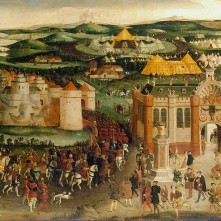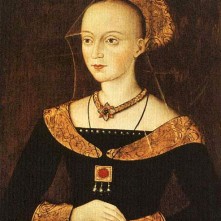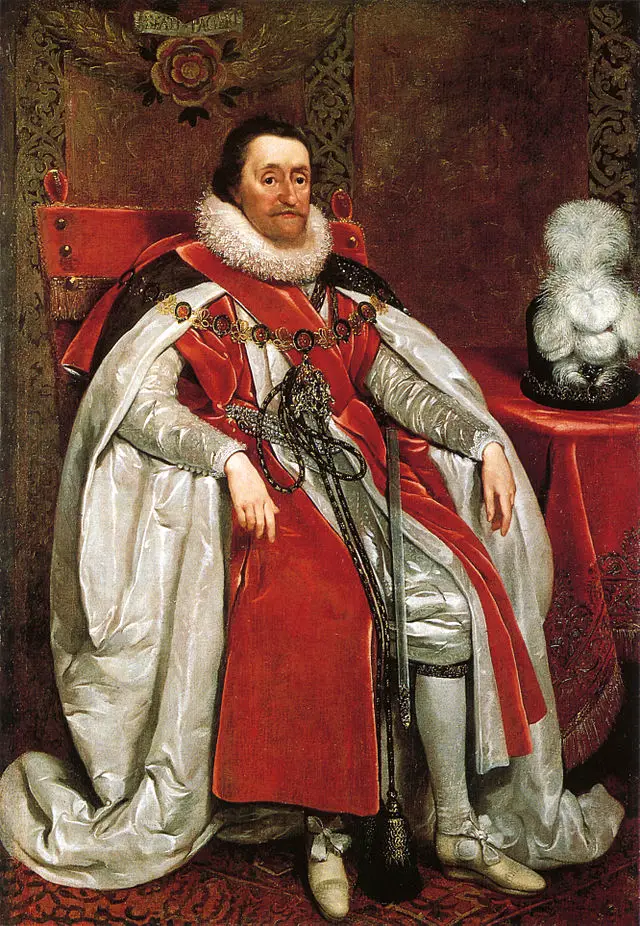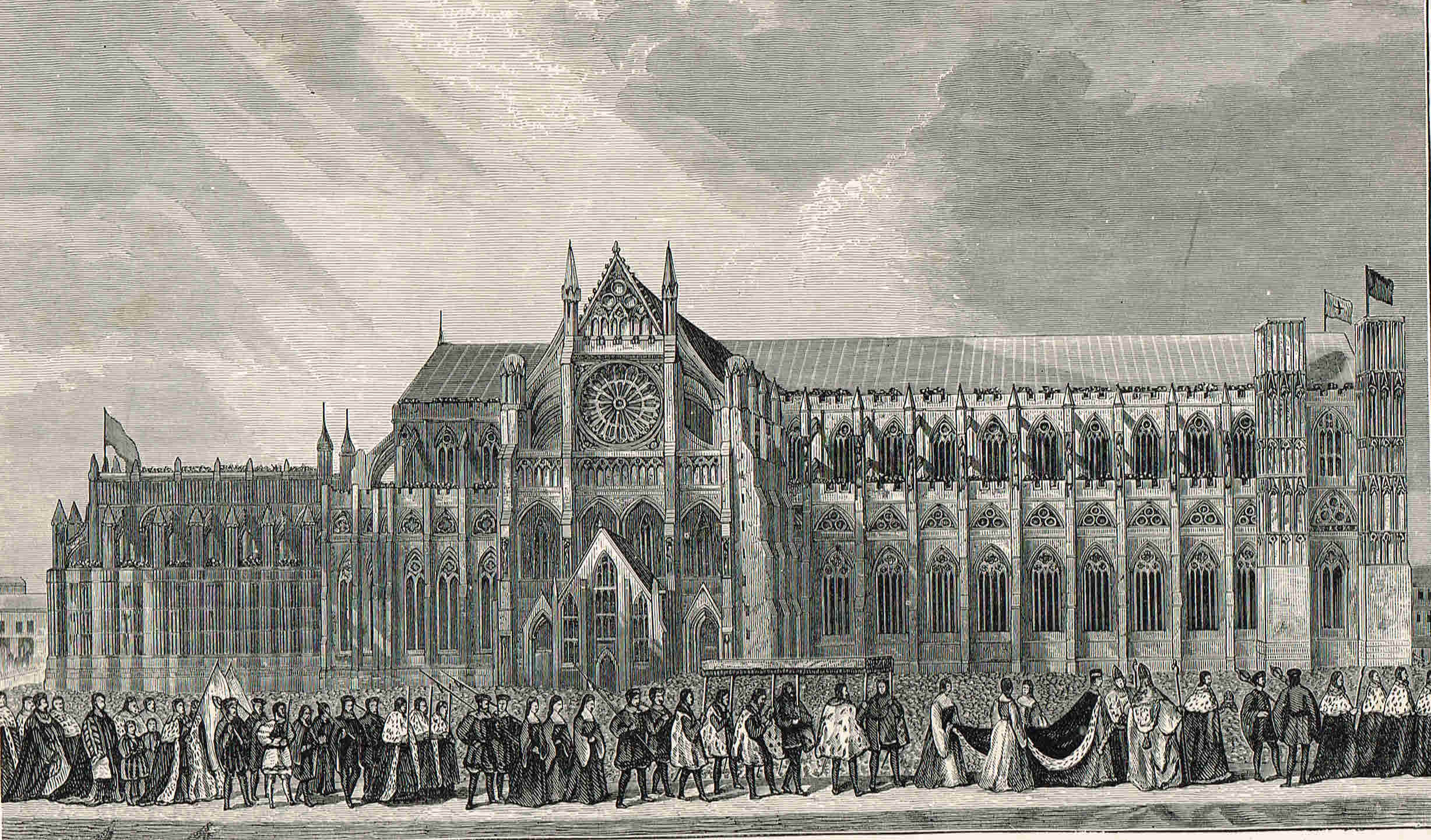6 June
1522 – Grand entry of Charles V, Holy Roman Emperor, into London, accompanied by King Henry VIII. There was pageantry and celebration.
1527 – Probable date for burial of Henry Algernon Percy, 5th Earl of Northumberland, in Beverly Minster.
1549 – An army of rebels assembled at Bodmin, Cornwall, and Mayor Bray convened a town meeting where resolutions were put containing the demands of the rebels who were against the introduction of the new “Book of Common Prayer”. This led to the Prayer Book Rebellion.
1556 – Birth of Edward la Zouche, 11th Baron Zouche, at Harringworth, Northamptonshire. He was the only son of George la Zouche, 10th Baron Zouche of Harringworth, and his wife, Margaret. Zouche was a landowner, diplomat and member of James I's Privy Council.
1563 – Baptism of Robert Cecil, only son of William Cecil, 1st Baron Burghley, and his wife, Mildred, at St Clement Danes, Strand.
1597 – Death of William Hunnis, musician and conspirator. He was Master of the Children of the Chapel (royal) in Elizabeth I's reign. He was imprisoned in 1556 in the Tower of London after being involved in a plot to rob the treasury, and was released when Elizabeth I became Queen.
1605 – Playwright William Haughton made his will and died in the next couple of days. His plays included "Englishmen for my Money, or, A Woman will Have her Will", "Patient Grissil" and "Grim the Collier of Croydon, or, The Devil and his Dame", and he wrote or co-wrote many more.
1618 – Death of Sir James Lancaster, merchant and Director of the East India Company, in London. He was buried in All Hallows, London Wall.
7 June

Field of Cloth of Gold
1520 - The first day of the historic meeting between Henry VIII and Francis I of France between the English stronghold of Guînes and the French town of Ardres, on a piece of land referred to as the Field of Cloth of Gold.
1532 – Birth of Amy Robsart (later Lady Dudley) probably at Stanfield Hall, Norfolk. Amy was the daughter of Sir John Robsart of Syderstone, Norfolk, and his wife, Elizabeth. Amy married Robert Dudley, Elizabeth I's favourite, in 1550.
1536 – A water pageant was held in honour of Jane Seymour, the new queen, on the Thames.
1546 – Henry VIII and Francis I signed the Treaty of Ardres (also known as the Treaty of Camp).
1592 – Death of Peter Osborne, administrator. He was buried at St Faith's under St Paul's. He held offices in the Exchequer during Edward VI's reign and is thought to have supported Lady Jane Grey. Osborne served Elizabeth I as an ecclesiastical commissioner and various other posts.
1594 – Roderigo Lopez, Elizabeth I's physician, was hanged, drawn and quartered at Tyburn after being accused by Robert Devereux, Earl of Essex, of conspiring with Spanish emissaries to poison the Queen. Lopez maintained his innocence, and the Queen seemed unsure of his guilt. It is thought that the charges were trumped up. Trivia: Lopez may have been the inspiration for Shakespeare's character, Shylock, in “The Merchant of Venice”.
1599 – Death of Henry Porter, playwright, after being mortally wounded in his left breast by a rapier in an assault carried out by John Day, a fellow writer.
1604 – Death of John Ley, explorer, in London. He was buried in the chancel of St Andrew by the Wardrobe. Ley was the first Englishman to enter the Amazon and one of the first to explore the coast of Guiana.
1618 – Death of Thomas West, 3rd Baron De La Warr, colonial governor (of Virginia), at sea, on his way to Virginia.
8 June
1476 – Death of George Neville, administrator and Archbishop of York, at Blyth in Nottinghamshire. He was buried in York Minster.
1492 – Death of Elizabeth Woodville at Bermondsey Abbey. Elizabeth was the consort of Edward IV and mother of the Princes in the Tower. She was buried beside her husband in St George's Chapel, Windsor Castle. You can read more about Elizabeth Woodville in June 2015's Tudor Life magazine - click here.
1533 – Papal authority in England was denied by Parliament.
1536 – Parliament passed the second “Act of Succession” removing Henry VIII's daughters, Mary and Elizabeth, from the line of succession.
1536 – Henry Fitzroy, Duke of Richmond, made his last public appearance (at Parliament) before his death.
1590 – Death of Thomas Randolph, Elizabethan diplomat, at his home in St Peter's Hill, London. He was buried at St Peter Paul's Wharf. Randolph acted as a go-between for Elizabeth I and Mary, Queen of Scots, and also served his Queen in Russia and France. He has been described as the first English "career diplomat".
9 June
1511 – Death of William Courtenay, 1st Earl of Devon, at Greenwich. He died of pleurisy and was buried at Blackfriars, London, with the honours due an earl, even though he hadn't been officially invested yet. Courtenay was Henry VIII's uncle, having married Katherine, daughter of Edward IV and Elizabeth Woodville.
1563 – (or 10th June) Death of William Paget, 1st Baron Paget, diplomat and administrator, probably at his estate of West Drayton in Middlesex. Paget's career included serving as an ambassador to the French court, being a member of Henry VIII's Privy Council, sitting on the commission which tried the Earl of Surrey and serving on Mary I's Privy Council.
1573 – Death of William Maitland of Lethington, Scottish courtier, politician, reformer and diplomat. He died in prison in Leith, in suspicious circumstances, though it was said to be suicide. Maitland supported the restoration of Mary, Queen of Scots, and was imprisoned as a result.
1583 – Death of Thomas Radcliffe, 3rd Earl of Sussex, Lord Lieutenant of Ireland and President of the Council of the North, at Bermondsey. His body was buried at Boreham in Essex, but his innards were buried at the church in Bermondsey.
10 June
1464 – Birth of John Islip, Abbot of Westminster, probably at Islip, Oxfordshire. Islip became Abbot of Westminster in 1500, and was the last to hold this office by free choice of the community.
1528 – Birth of Thomas Percy, 7th Earl of Northumberland. Percy was a staunch Catholic, and was involved in the failed Rising of the North in Elizabeth I's reign. He fled to Scotland, but was captured and taken to York on 22nd August 1572, where he was beheaded in the Pavement, and his head put on display on Micklegate Bar. His body was buried in St Crux Church.
1537 – Deaths of Blessed Thomas Green and Blessed Walter Pierson, Carthusian monks from London Charterhouse, in Newgate Prison, from starvation. They were two out of nine monks who were purposely starved to death for refusing to accept the royal supremacy. Others were hanged, drawn and quartered.
1540 - Arrest of Thomas Cromwell, 1st Earl of Essex, in the council chamber at Westminster. Click here to read more about it.
1584 – Death of Francis, Duke of Anjou and Alençon, a suitor whom Elizabeth I dubbed "Frog", in Paris. It is thought that he died of malaria.
1607 – Death of Sir John Popham, lawyer, Judge and Speaker of the House of Commons. He was buried in Wellington, Somerset.
1612 – Funeral of Robert Cecil, 1st Earl of Salisbury, at Hatfield.
11 June
1456 – Birth of Anne Neville, Queen Consort of Richard III, at Warwick Castle. Anne was the daughter of Richard Neville, 16th Earl of Warwick and 6th Earl of Salisbury, known as the Kingmaker, and his wife, Anne Beauchamp.
1488 – Death of James III of Scotland, at Sauchieburn, or “the field of Stirling”. It is not known whether he died in battle or after the battle.
1509 – Marriage of Henry VIII and Catherine of Aragon at Greenwich Palace - click here to read more about it.
1540 – Birth of Barnabe Googe, translator and poet. Googe is known as one of the earliest English pastoral poets.
1544 – Bishops ordered by Henry VIII to ensure that the new litany was “in our native englysshe tonge”.
1560 – Death of Marie de Guise (Mary of Guise), former consort of James V and regent of Scotland, at Edinburgh Castle. Her body lay in a lead coffin at the castle, in St Margaret's Chapel, until March 1561 when it was taken back to France. Marie was buried in the convent of St Pierre at Rheims.
1576 – Death of Sir Anthony Cooke, humanist and educator. Cooke educated his daughters to a high standard, teaching them Latin and Greek, and probably also modern languages and Hebrew. He was appointed royal tutor to Edward VI, but it is not known whether he actually tutored the King. It may have been more of a guiding role. He was buried at Romford, and his effigy can be seen at St Edward's Church there.
12 June
1492 – Burial of Elizabeth Woodville, former consort of Edward IV, next to her husband in St George's Chapel, Windsor Castle.
1511 – Burial of William Courtenay, 1st Earl of Devon, at Blackfriars.
1530 – Catherine of Aragon told Henry VIII to abandon his “wicked” life.
1535 – Richard Rich interviewed Sir Thomas More in the Tower of London. He later reported, at More's trial, that More had denied the royal supremacy during this interview.
1540 - The newly imprisoned Thomas Cromwell wrote to King Henry VIII from the Tower of London, asking for mercy and pleading his innocence.
1553 – Edward VI's council commanded the judges of the King's Bench to turn Edward's "Devise for the succession" into a legal will.
1567 – Death of Richard Rich, 1st Baron Rich and Lord Chancellor, at Rochford. He was buried at Felstead. Richard Rich was Lord Chancellor in Edward VI's reign and went on to serve in Mary I's Privy Council.
1573 – Birth of Robert Radcliffe, 5th Earl of Sussex, courtier and soldier. He was the son of Henry Radcliffe, 4th Earl of Sussex, and his wife, Honor. Radcliffe served Elizabeth I as an ambassador and as Earl Marshal and Colonel General of her army. He was appointed Lord Lieutenant of Essex by James I in 1603.









Leave a Reply